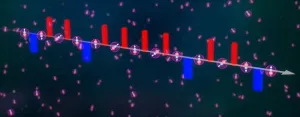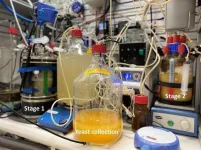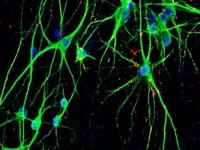(Press-News.org) The interactions between quantum spins underlie some of the universe’s most interesting phenomena, such as superconductors and magnets. However, physicists have difficulty engineering controllable systems in the lab that replicate these interactions.
Now, in a recently published Nature paper, JILA and NIST Fellow and University of Colorado Boulder Physics Professor Jun Ye and his team, along with collaborators in Mikhail Lukin’s group at Harvard University, used periodic microwave pulses in a process known as Floquet engineering, to tune interactions between ultracold potassium-rubidium molecules in a system appropriate for studying fundamental magnetic systems. Moreover, the researchers observed two-axis twisting dynamics within their system, which can generate entangled states for enhanced quantum sensing in the future.
In this experiment, the researchers manipulated ultracold potassium-rubidium molecules, which are polar. As polar molecules are a promising platform for quantum simulations, the tunable molecular interactions using Floquet engineering could open new doors for understanding other quantum many-body systems.
“There is a lot of interest in using these quantum systems, especially [with] polar molecules— there can be sensitivity to many new physics effects because the molecules have a rich energy structure that depends on many different physical constants,” explains JILA graduate student, and the study’s first author, Calder Miller. “So, if we can engineer their interactions, in principle, we can create entangled states that give better sensitivity to new physics.”
Implementing Floquet Engineering
Floquet engineering has emerged as a useful technique for driving interactions within physical systems. This method acts like a “quantum strobe light,” which can create different visual effects, like making objects appear to move in slow motion or even stand still, by adjusting the speed and intensity of the flashes.
Similarly, by using periodic microwave pulses to drive the system, scientists can create different quantum effects by controlling how particles interact.
“In our old setup, we were limited in the number of pulses we could drive,” says Annette Carroll, a JILA graduate student on Ye’s research team and a fellow author of this study. “So, we worked with the electronics shop to develop an FPGA-based arbitrary waveform generator, which allows us to apply thousands of pulses now. This means that not only can we engineer a pulse sequence that removes single particle noise, but we can also modify the interactions in the system.”
Before implementing the Floquet engineering, the researchers first encoded quantum information in the molecules' two lowest rotational states (though molecules have many more states). Using an initial microwave pulse, the molecules were put into a quantum superposition of these two “spin” states.
After encoding the information, the researchers used the Floquet engineering technique to see if they could tune specific types of quantum interactions, known as XXZ and XYZ spin models. These models describe how the particles’ inherent quantum spins interact with each other, which is fundamental to understanding magnetic materials and other many-body phenomena.
While physicists use a mathematically constructed Bloch sphere to show how spins evolve in these models, it can be easier to visualize the molecules as changing their dance pattern based on how they interact with their neighbors, or dance partners. These molecular dancers may switch from pulling or pushing on their partners, which, on a quantum level, can be equated to changes in spin orientation.
In the study, the “quantum strobe light,” or Floquet engineering, nudged these changes in interactions between molecules, which the researchers verified had produced similar spin dynamics to those generated by fine-tuning of the interactions using an applied electric field. In addition, the researchers precisely controlled the pulse sequence to realize less symmetric interactions that cannot be generated using electric fields.
Doing the (Two-Axis) Twist
The researchers also observed that their technique produced two-axis twisting dynamics.
Two-axis twisting involves pushing and pulling the quantum spins along two different axes, which can lead to highly entangled states. This process is valuable for advancing sensing and precision measurements, as it allows for the efficient creation of spin-squeezed states. These states reduce the quantum uncertainty in one component of a spin system while increasing it in another orthogonal component, leading to enhanced sensitivity in spectroscopy experiments.
“It was pretty exciting when we saw the initial signatures of two-axis twisting,” Miller says. We weren't sure that we were going to be able to make it work, but we tried it, and a day and a half later, it was pretty clear that we had a signal.”
The concept of two-axis twisting was proposed in the early 1990s, but its realization in two JILA laboratories had to wait until 2024. In addition to this work by Ye and his team, JILA and NIST Fellow and University of Colorado Boulder Physics professor James Thompson and his team used a completely different approach to working on atoms—cavity quantum electrodynamics, or cavity QED—also demonstrating two-axis twisting this year.
While the researchers did not attempt to detect entanglement in their system, they plan to do so in the future.
“The most logical next step is to improve our detection so we can actually verify the generation of entangled states,” Miller adds.
This work was supported by the US Department of Energy’s Office of Science, the National Quantum Information Science Research Centers, and the Quantum Systems Accelerator.
END
Polar molecules dance to the tunes of microwaves
2024-09-12
ELSE PRESS RELEASES FROM THIS DATE:
Quantum researchers cause controlled ‘wobble’ in the nucleus of a single atom
2024-09-12
Researchers from Delft University of Technology in The Netherlands have been able to initiate a controlled movement in the very heart of an atom. They caused the atomic nucleus to interact with one of the electrons in the outermost shells of the atom. This electron could be manipulated and read out through the needle of a scanning tunneling microscope. The research, published in Nature Communications today, offers prospects for storing quantum information inside the nucleus, where it is safe from external disturbances.
For weeks on end, the researchers studied a single titanium atom. “A Ti-47 atom, to be precise,” ...
Foods with low Nutri-Scores associated with an increased risk of cardiovascular diseases
2024-09-12
Cardiovascular diseases are the leading cause of mortality in Western Europe, accounting for 1/3 of deaths in 2019. Diet is thought to be responsible for around 30% of such deaths. Nutrition-related prevention policies therefore constitute a major public health challenge for these diseases.
In an article to be published on 11 September 2024 in Lancet Regional Health - Europe, researchers from the Nutritional Epidemiology Research Team (CRESS-EREN), with members from Inserm, Inrae, Cnam, Université Sorbonne Paris Nord and Université Paris ...
Research reveals reality of Ice Age teen puberty
2024-09-12
Landmark new research shows Ice Age teens from 25,000 years ago went through similar puberty stages as modern-day adolescents. In a study published today in the Journal of Human Evolution of the timing of puberty in Pleistocene teens, researchers are addressing a knowledge gap about how early humans grew up.
Found in the bones of 13 ancient humans between 10 and 20 years old is evidence of puberty stages. Co-led by University of Victoria (UVic) paleoanthropologist April Nowell, researchers found specific markers in the bones that allowed them to assess the progress of adolescence.
“By analyzing specific areas of the skeleton, we inferred things like menstruation ...
Use of biomarkers in the management of inflammatory bowel disease
2024-09-12
Inflammatory bowel disease (IBD), encompassing Crohn’s disease (CD) and ulcerative colitis (UC), is a chronic inflammatory disorder of the gastrointestinal (GI) tract that significantly impacts the quality of life of patients. With an incidence of approximately one in 200 individuals in developed countries and a rising trend in developing and newly industrialized nations, IBD poses a substantial burden on healthcare systems. Due to the nonspecific nature of its clinical manifestations and the lack of a gold-standard diagnostic test, managing IBD effectively remains a challenge. Therefore, reliable and widely available biomarkers ...
Powered by renewable energy, microbes turn CO2 into protein and vitamins
2024-09-12
Researchers in Germany can harvest protein and vitamin B9 from microbes by feeding them nothing much more than hydrogen, oxygen, and CO2. The technology, published September 12 in the Cell Press journal Trends in Biotechnology, runs on renewable energy to produce a sustainable, micronutrient-enriched protein alternative that may one day make it to our plates.
“This is a fermentation process similar to how you make beer, but instead of giving the microbes sugar, we gave them gas and acetate,” says corresponding author Largus Angenent of the University of Tübingen, Germany. “We knew that yeast could produce vitamin B9 on their own with sugar, however, we didn’t ...
Scientists aim to decode the genetic roots of mental illness on a large scale
2024-09-12
Neurodevelopmental and psychiatric disorders (NPD) including schizophrenia, bipolar disorder, autism, and depression are detrimental to individuals, their families and society as a whole, and in many cases still lack effective treatments. It’s becoming more and more clear that genetic mutations in certain genes can increase the likelihood of developing NPD, and several hundreds of those “risk genes” have been identified to date, but their role related to NPD remains a mystery. “Very little is known about the basic function of most of these genes, and what we do know ...
Retinopathy associated with hair dye
2024-09-12
About The Study: This case report describes a woman who presented with bilateral blurry vision a few days after dyeing her hair with hair dye containing aromatic amines.
Corresponding Author: To contact the corresponding author, Nicolas Chirpaz, MD, email nicolas.chirpaz@chu-lyon.fr.
To access the embargoed study: Visit our For The Media website at this link https://media.jamanetwork.com/
(doi:10.1001/jamaophthalmol.2024.3453)
Editor’s Note: Please see the article for additional information, including other authors, author contributions and affiliations, conflict of interest and financial ...
Race, social determinants of health, and the quality of diabetic eye care
2024-09-12
About The Study: This study found that certain social determinants of health affected monitoring for diabetic retinopathy similarly for Black and white patients with diabetes while others affected them differently. Patients living in rural communities, Black patients with preexisting diabetic retinopathy, and Hispanic white patients were not receiving eye care in accordance with clinical practice guidelines, which may contribute to worse outcomes.
Corresponding Author: To contact the corresponding author, Dustin D. French, PhD, email dustin.french@northwestern.edu.
To access the embargoed ...
Molecular, socioeconomic, and clinical factors affecting racial and ethnic disparities in colorectal cancer survival
2024-09-12
About The Study: This single-center cohort study identified substantial overall survival disparity and differing frequencies of driver gene variations by race and ethnicity. Socioeconomic status had the largest contribution but accounted for less than one-third of the disparity, with substantial contribution from tumor molecular features. Further study of the associations of genetic ancestry and the molecular pathogenesis of colorectal cancer with chemotherapy response is needed.
Corresponding ...
City of Hope and Biopharmaceutical Research Company announce first patient has received BRC-001, a first-in-class cannabinoid therapeutic, in a clinical trial investigating supportive care in breast c
2024-09-12
City of Hope and Biopharmaceutical Research Company announce first patient has received BRC-001, a first-in-class cannabinoid therapeutic, in a clinical trial investigating supportive care in breast cancer
Researchers will evaluate whether the cannabinoid therapeutic candidate can address joint pain resulting from cancer treatment using aromatase inhibitors
This side effect has caused many breast cancer patients to discontinue treatment
LOS ANGELES and MONTEREY, Calif. — City of Hope®, one of the largest cancer research and treatment organizations in the United States, and Biopharmaceutical Research ...




